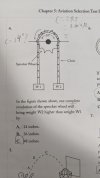Hello everyone,
I finished my third and final attempt at the ASTB this morning and I am happy to have scored the following: 58 8/8/8.
As a thank you for all of the helpful information I have found on this forum when I started my journey to become an SNA, here is a compiled list of all the study guides, practice tests, simulators and equipment I have used to improve my scores and a few tips on how to effectively use them.
Kyle's Drive
Made by Kyle Swaters, contains study guides and practice tests for the Math Skills Test (MST), Mechanical Comprehension Test (MCT) and Aviation and Nautical Information Test (ANIT) portions of the ASTB.
Gomez's Drive
Made by Ado Gomez, contains study guides and practice tests for the MST, MCT and ANIT portions of the ASTB.
ANIT Flash Cards
415 different flashcards to help study for the ANIT portion of the ASTB.
ASTB Prep App
$25.00 App that can be purchased on the Apple Store to help prepare for the entirety of the ASTB exam, including Performance Based Measures Battery (PBM). I
strongly recommend using it to study for the MST and MCT of the ASTB, as well as practicing the Dichotic Listening Test, UAV Simulator and Terrain Identification.
Jantzen and Mike's ASTB Trainer (Modified)
This is a modified version of Jantzen and Mike's throttle and joystick simulator for the ASTB. It includes emergency test scenarios and the Dichotic Listening Test is changed to more accurately emulate the ASTB; it changes which headphone to listen to (i.e. left or right). For a more realistic experience, I used the
Logitech G X52 and bound the key controls to them using
JoyToKey.
NOTE: The program has the acknowledge ear command key bindings configured opposite of how it actually is on the test. I suggest reconfiguring the key binds so that when an even number is heard, you press the trigger on the joystick (right click the mouse) and when an odd number is heard, you press the button on the throttle (press the letter key "E"). This can also be done using JoyToKey.
TIPS AND TRICKS
For the UAV Simulator Portion of the exam, draw a compass onto a small piece of paper (North, South, East, West) and stick the point of a pen or pencil directly through the center. This
video goes into more detail, except he uses his hands to turn the paper compass. Using a pencil or pen to spin the compass in the indicated direction the UAV is moving will improve your response time. Aim to achieve 100% accuracy and an average response time of less than 2 seconds.
Prior to the test date, it may be a good idea to have your ears cleaned to ensure that you can clearly hear the headphone commands for the Dichotic Listening Test (You would be amazed by how much ear wax can build up).
For the emergency scenarios portion of the PBM, make sure to write down the instructions on how to handle each scenario for reference. During my test, it had me handle each emergency scenario in the same order they were listed on the instructions page. It may be a good idea to pre-emptively set the fuel and engine knobs to their respective setting prior to each scenario being displayed so that the warnings can immediately be dismissed.
I hope I was helpful to any aspiring SNAs and SNFOs, please feel free to message me with any questions or comments.
Cheers!


